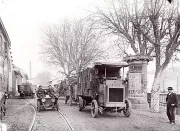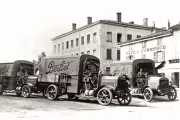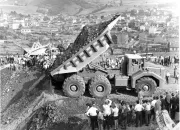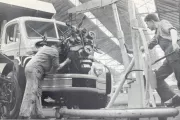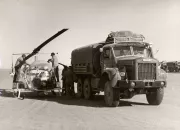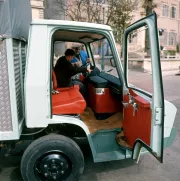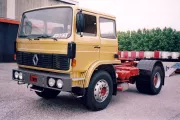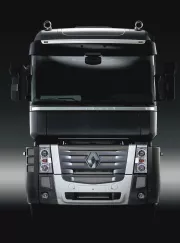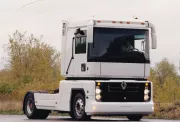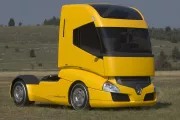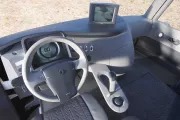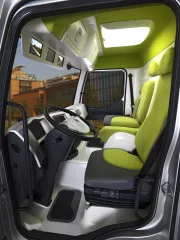Welcome to Renault Trucks Content Hub
Report
The History of Renault Trucks
Jul. 11 2023
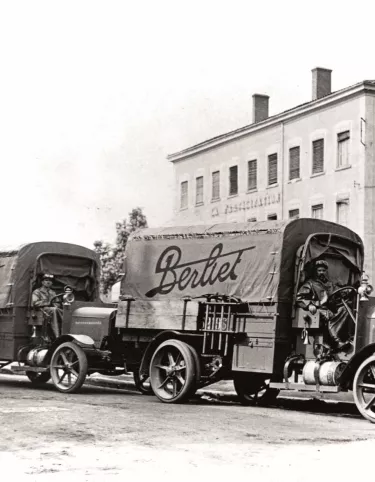
Discover the history of Renault Trucks
From 1894 to today
Building on its outstanding history, Renault Trucks’ destiny is now gathering pace on highways all over the globe.
Renault Trucks has a history we can all be proud of. This history explains what Renault Trucks is today and what it will be in the future: a committed brand to serve its customers and road transport as a whole, as well as enhancing the prestige of an activity which plays a key role in our society.
- The era of the pioneers : 1894 - 1906
- The first Berliet Trucks: 1909 - 1913
- First mass production : 1914 - 1918
- Diversification for business sustainability: 1918 - 1928
- The emergence of the iconics Berliet Trucks: 1952 - 1978
- Towards world leadership: 1983 - 1985
- The lengendary Magnum Era: 1990 - 2008
- The new Renault Trucks Era: 1996 to 2007
- Renault Trucks, the pioneer of the electric world
The era of the pioneers : 1894 - 1906
In 1894 in Lyon, Marius Berliet designed and produced a single cylinder engine and made his first petrol car running on petrol until the present day.
In 1906, he made his first truck.
In 1898 in Billancourt, near Paris, Louis Renault developed a 4 speed gearbox and introduced his first motorised vehicle, a small car with a quarter horse power.
He produced the first direct drive utility vehicle (LCV) from 1900 and in 1906 invented the fore runner to the Paris bus.
Discover more than 100 years of an extraordinary legacy by watching “Pioneers since 1894”
The first Berliet Trucks: 1909 - 1913
The Berliet M - 1909
The Berliet M is considered the first truck of the modern era. It has a special chassis allowing it to move 3,500 kg of payload at up to 25 km/h.
Berliet Type CBA 1913: "The unstoppable"
With its body, it weighs about 3.5 tons unladen and can carry a payload equivalent to a maximum speed of about 30 km/h.
First mass production : 1914 - 1918
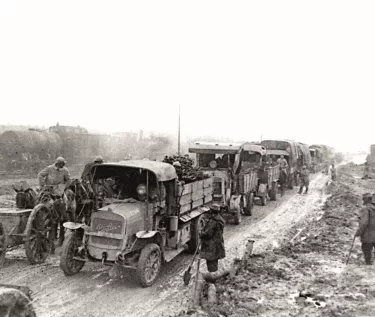
At Berliet, 40 CBA trucks were produced each day to join those going to the front at Verdun. At Renault, the 600 taxis that contributed to the victory at the Marne assured Renault’s place in history.
In 1917, the ‘diamond’ brand built the first modern tank in history. The first 4x4 truck was built by Latil. It was a natural step following the front-wheel drive developed in 1898.
Diversification for business sustainability: 1918 - 1928
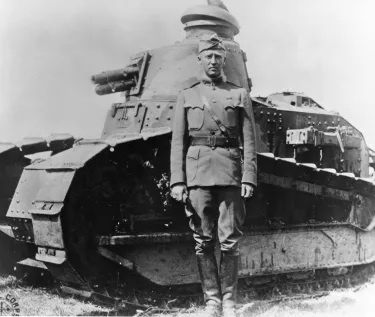
Louis Renault and Marius Berliet deployed industrial genius to form their car manufacturing group. Berliet was also involved in producing the Renault FT17 tank ordered by the French government.
In 1923, Renault was the first brand to offer a road-going tractor unit. In the same year, vehicles equipped with engines fuelled by gas derived from burning wood and the first tractor unit with servo brakes on all 4 wheels appeared. But the great revolution of this period was the introduction of the diesel engine in 1930, which transformed road transport. Thanks to its low running costs and power at low engine speeds, it proved to be the best tool for transporting goods.
The emergence of the iconics Berliet Trucks: 1952 - 1978
Steps towards building a group
Betwen 1952 and 1974, Laffly, Rochet Schneider, Camiva and Citroën HGV merged with Berliet.
In 1955 Saviem was formed from the merger of Latil, the Trucks division of Renault and Somua.
In 1957 Berliet made the T100, the largest truck in the world.
Richard Continental joined Saviem in 1965 and Sinpar joined in 1975.
In 1978, Berliet and Saviem merged to form the only HGV manufacturer in France which became Renault Véhicules Industriels, the Trucks division of the Renault Group.
The Berliet T-100 - 1957
This is one of the largest trucks ever built in the world, with a gross vehicle weight of over 100 tonnes.
The Berliet GLR8 - 1958 – The “truck of the century”
The Berliet GLR, launched in January 1950 with a GVW of 12.5 t, ended its career 31 years later at 19 t.
The Berliet GBC - 6x6 "Gazelle" - 1959
Designed in 1956 to meet the demands of desert oil exploration, the GBC has a large 7.9 litre engine. It is remarkably well balanced with a virtually identical load on each of the three drive axles.
Berliet Stradair – 1965
The Berliet Stradair, the world's first truck with variable air-cushion suspension. In the early 1960s, Berliet decided to launch a five-tonne payload vehicle, the Stradair, in the urban delivery segment.
Berliet TR 300 – 1970
In 1970, Berliet presented its brand-new long-distance truck, the TR 300, equipped with the V8 engine and its over-engine tilting cab, the KB2400.
Towards world leadership: 1983 - 1985
Renault Vehicules Industriels sought to build an international group with the acquisition of Dodge Europe in 1983.
Some iconic trucks emerged at this time...
The Renault G 260 - 1983
The G260 has been designed to be as economical as possible. It has opened a new niche for long and medium-distance transport with a focus on payload and profitability.
The Renault V.I.R.A.G.E.S
Starting in 1980, the V.I.R.A.G.E.S. program (Véhicule industriel de recherche pour l’amélioration de la gestion de l’énergie et la sécurité - Commercial vehicle for research into the improvement of energy management and safety) focused on studying a certain number of technical options designed to be featured in future production vehicles. This program resulted in the building of two VE (experimental vehicle) prototypes, named the VE 10 (1985) and the VE 20 (1988).
The lengendary Magnum Era: 1990 - 2008
Renault Trucks' context
Renault Vehicules Industriels sought to build an international group with the acquisition of the highly respected American Mack truck brand in 1990.
1992 was a key stage: Renault Vehicules Industriels became Renault V.I.
In 2001, Renault V.I. became part of the Volvo Group.
In 2002, the worldwide brand Renault Trucks was formally constituted.
The birth of the legendary Magnum Truck
As soon as it was born, the Renault Magnum was destined to mark its age with its stamp. Everyone remembers the impact of its revolutionary concept at its launch in 1990. A totally flat cab floor, headroom of 1.87 m - now over 2 m - unequalled spaciousness, total freedom to move around on board, and more. The Renault Magnum cab’s characteristics made it one of the most comfortable trucks on the market.
Rapidly asserting itself as the benchmark in its category, the following year it was voted "Truck of the Year".
Ever since, the Renault Magnum had been constantly improved until 2013 when the very last models were produced.
The new Renault Trucks Era: 1996 to 2007
Renault Trucks launched new trucks with never seen designs and technical solutions
The HSV, High Safety Vehicle - 1996
In 1996, Renault V.I. has designed a High Safety Vehicle -HSV -i.e. a laboratory vehicle that integrates a maximum number of technical solutions designed to improve safety. HSV is based on a Renault Magnum tractor and includes a trailer in a top limit van configuration; this trailer also benefits from a maximum number of elements intended to strengthen safety.
Radiance, The Dream Truck - 2004
In 2004, Renault Trucks imagined a dream truck, foreshadowing long-term prospects for driver comfort and safety as well as for the productivity and image of long-distance transport companies. Innovation in styling has been at the heart of the thinking process.
Renault Trucks Hybrys - 2007
Renault Trucks presented Hybrys in 2007, an innovative urban concept vehicle that uses parallel hybrid technology combining a combustion engine and an electric motor to provide power to the wheels according to different power distribution scenarios.
Renault Trucks, the pioneer of the electric world
In 2013, Renault Trucks completely renewed its range of trucks, a first in the world of commercial vehicles. The Renault Trucks T High and T models for long distance, C and K for construction, D and D Wide for distribution feature innovative design and increased fuel efficiency. In 2015, the Renault T High was named International Truck of the Year
Committed to the energy transition and sustainable mobility, Renault Trucks is the pioneer in electromobility with the marketing of a 100% electric 4.5 t truck in 2011. In 2023, Renault Trucks offers a complete range of carbon-free vehicles, from 650 kg to 44 t GVW, mass-produced in France.

